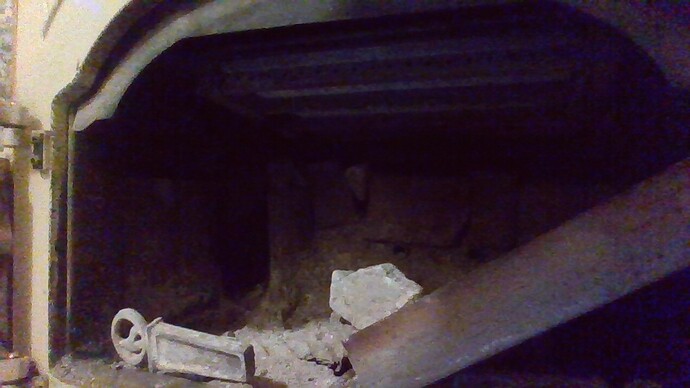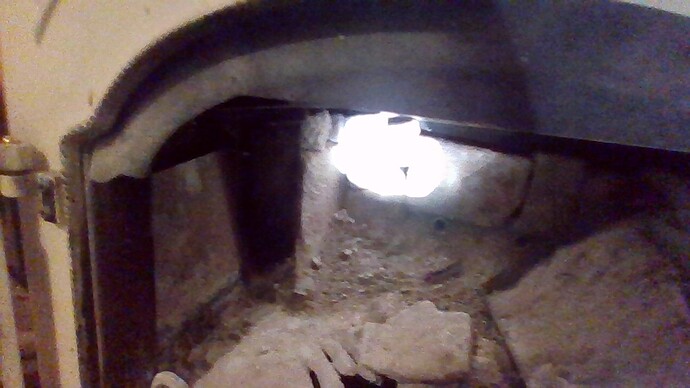Now they are adding fiber. I think it should be strong and durable. Do you think this would be good for a gasifier restriction?
Rindert
It would probably work great. You would need to be careful with the poker though 
What kind of fiber are we talking about?
I think its probably alumina, but it may be some other kind of mineral. Probably it is the same as in ceramic blankets.
Yes, I think better not to use a poker if possible.
Rindert
I’ve been thinking about this for a while. I made the heat riser on my Rocket Mass Heater by lining an 8 inch duct with a one inch layer of ceramic blanket. Much easier than any other way to build a heat riser and after a year of use the blanket is a little darker but otherwise no effect. Supposedly the heat in that tube reaches steel eating temps. I did not think that the blanket would be durable enough for a fire tube without a thin shell over it. When I built the heater I just used this stuff https://www.menards.com/main/building-materials/concrete-cement-masonry/bagged-concrete-cement-mortar/akona-reg-medium-duty-refractory-mortar-50lb/1891185/p-1444445324433.htm to mortar the fire brick and also covered the outside of the fire brick with it. Not sure what temps it’s stable to. Takes a real long time to cure. I also filled the base of my charcoal gasifier with it, For a fire tube I was thinking of using a metal tube lined with ceramic blanket and having a sacrificial metal tube in the core so that some kind of pourable refractory could be place between that and the blanket. All the refractory cements I’m familiar with are mortar and would have to be lightly rammed in place. That blanket would not stand up to that. There is a thread about using waterglass as an amendment to make a shell like that on Permies.
Water glass and pearlite (rocket mass heater forum at permies)
Also the overall dimension for the finished fire tube would be about 15 inches.
Doing this do not loose sight of what you are trying to achieve.
If you are after the best heat conserving from the insulative matting then too much of the cast-able refectory and you can push your self into mass-thermal storage. With it’s pro’s and cons.
If you were after mass-thermal benefits the space taken by the matting reduces within a given volume your mass effects.
Why I still suggest the stove thermal bricks. They are in three common densities trading off the insualtive for the mass-weight durability. Side bricks versus floor bricks.
Then there are the full dimensions kiln insulative bricks. So insulative soft you can shave then with a knife.
The tendency is to overdo.
For me the bricks are just sacrificial to save the outer gas tight metals. I want them easy out replaceable.
S.U.
I am attempting to show you use in my wood stove of four five different material for different benefits. Ha! And all of these material except for the insulative ash have been in place for 20,000 hours +.
The two black upright L.H columns are hollow boxed cast iron. The front one heated air feeding the door front glass air shower. The rearward one active charcoal glow super heated feeding air upward into the first pictures top, side across secondary air tubes.
Stainless steels: those inserted loose fitting hollow secondary air tubes; the L.H. grey square between the two upright blackened cast iron columns (this ss just a slide in panel to trap ash behind it); and the R.H. side propped up ash capturing tray from down below the grate -1.5mm SS with a pre-filled bed of insulative ash put inside by me.
Then the back wall insulative just set in place stove bricks. Also one full brick and brick chunks set across the heavy cast iron floor grated been center burnt out for years. Why buy or make a new metal grate, eh when bricks are only $3.00-5.00 usd each?
Final: just visible at the lower back are the two round protruding carbon steel back wall starting fire air nozzles.
These and the cast iron upright columns are destruction saved by the heat absorbing flow outwards air flows. That grate did not have a chance direct hot char in contact. Destroyed by the third year. Say 6,000 hours.
Each material used to the best overall benefit.
And again each used properly with a min. useable 20,000 hour life span.
Regards
Steve unruh
I have cut the inch and a quarter firebrick with my tile saw. Cuts easily. Chamfering the edges for a tight fit between bricks would be no problem. I would then pack them into the external metal form with enough mortar to fill the minor voids between the bricks and the tube. Buttering the edges of the bricks may not be necessary. For further heat retention the ceramic blanket could be wrapped around the outside of the metal tube and secured with hardware cloth. I would be careful drilling the bricks for nozzles. The thin ones are easily cracked.
Yes, that is good advice, but sometimes hard to follow.
Anyhoo, Having worked in foundry I know about crucibles. I good silicon carbide crucible can survive for a year or more in every day operation. Sooo, what about a silicon carbide restriction? I think I could chip the center out of a grinding wheel (silicon carbide) to make something that would be a very large thermal mass and fairly durable.
Rindert
Thanks for the insite Steve, that thought was in my undesided rought too go here. Changeing the refractory mix more insulate, or just putting thinner coat over blanket. Might just have too experiment , too see how well it holds up thin first,
I started out looking for the pipe used to fuel space craft with liquid hydrogen , Failing that I looked to heat shield . This works but is too heavy .
Yes the weight adds up fast. The ceramic blanket works well in the burn tube liner. Probley
just a thin coat of satanite would be enough too keep the ceramic dust too minimum. Is all I was going for, and a little higher temp resistance the coatings are too.
All stainless steel . Thick outer case insulation blanket thin inner held in by being springy no fastener . Reduction cone . thin welded stainless steel , Melted folded distorted cracked .
Cone is too small , Just a blockage . Put system back together burnt out blower fans did not run system . At reduction it is possible to just have reduction and build cone of ash . There is a part on a jet engine that can be adjusted on the fly that is a reduction cone . The TF30’s afterburner nozzles are regulated open or closed individually by each engine’s afterburner fuel control system. Spending to have built an reduction from highest temperature material would be cost prohibitive and I am not sure it would last . I do feel a part made from this material can be incorporated in some way .
I SUPOSE lots of ceramic coatings would work in the restrictor areas, mine restrictor is removable ,so I can just replace when it burns out. Last a long time with out coatings on my miled steel cone restrictor.

